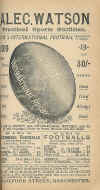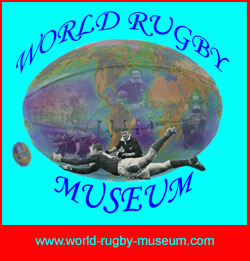|
Development of the Rugby Ball
|
|
|
EXHIBITION HOME - World Rugby Museum Home - Rugby in the town of Neath - RUGBY RELICS HOME
|
Development of the Rugby Ball
|
|
|
|
The town of Rugby, Warwickshire and in
particular two businesses close to the school, Gilbert's and Lindon are chiefly
responsible for the development of the rugby ball as we know it today. In fact
'Gilbert's' are still regarded as the number one name in the rugby ball
industry.
Originally a pig's bladder was used for football in the public schools of England, but unfortunately for the pigs, the life span of a sporting bladder was short and they needed to be replaced regularly. The solution to the problem was for the bladder to be covered with leather and local shoemaker's were called in to solve the problem. By 1800, leather casings surrounded the bladder, which is naturally oval in shape, to prolong the life of the ball. By the 1840s the aforementioned William Gilbert and Richard Lindon, cobblers by trade of Rugby, were both supplying balls, boots and other equipment to the masters and boys of Rugby School. In the 1850s vulcanised rubber was invented by an American, Charles Goodyear. Richard Lindon applied this method to the manufacture of bladders for his footballs but failed to patent the process. Others soon caught on and by the 1880s there were several manufacturers of 'footballs' in England all using the same process. Lindon is also credited with inventing the adaptor with which to blow up the ball, previously the stem of a clay pipe which was attached to the bladder was used. His wife had contracted a lung disease thought to have come from years of blowing up the pig's bladders with the stems, out of necessity a new method was born. The first mention of standard dimensions for a ball are in 1892. The RFU required that they were to measure 25.5 - 26 inches in width circumference and 30 - 31 inches in length circumference. In 1931 the dimensions were changed to the shorter and much narrower ball that is used today. |
|

|
Rugby Ball - circa 1900 - This ball dates from around 1905, the original bladder has disintegrated and this has been replaced with a modern bladder. (WRM-0129) |
| Ball-1906 | |
| 1906 Springboks signed ball. A 'Zug' ball possibly manufactured in South Africa but certainly available for purchase in SA, see the Perrins & Burke, Port Elizabeth advert, where you can buy the 'Zug' for 15 shillings. This advert is dated 1910. The signatures have faded on the ball and written on one of the panels is 1906 Springboks, this can only be seen at a certain angle and light, there may be more, match balls at this time were normally autographed by both teams who had played in a match. The bladder has been replaced in this ball. This ball is certainly a case for the conservationist. The bottom illustration is a photo of a signed ball of the 1906 tourists as illustrated in Piggot's book of the tour. (WRM-0357) | |
| Ball-Za | |


|
An 8 panel South African ball, circa 1930s. Keeping with the guidelines of the International Rugby Board each country developed it's own style of ball, the South Africans tended towards an 8 panelled ball and played with this type up until 1961 when the IRB decreed that 4 panels per ball should be the standard. (WRM-0127) |

|
Gilbert Barbarian - one of the first balls with an artificially coated surface to aid handling in wet weather. (WRM-0354) |
| Ball-Mins | |

|
Miniature balls were produced by Gilbertís as gifts & keepsakes. They were popular with touring teams who presented signed miniatures to their hosts. This is a minature ball signed by the 1938 British Lions. (WRM-0234) |

|
Miniature balls signed by Bleddyn Williams, 1950s Welsh captain. (WRM-0312) |
|
|
Miniature ball produced for Barbarians Centenary Dinner 1990 and bladder. (WRM-0305) |
| bladder | |

|
Typical bladder, circa 1950s. (WRM-0128) |

|
Tobacco pouch in the shape of a rugby ball, Gilbert and other manufacturers used to sell these to boost sales of their leather goods. (WRM-0309) |

|
1896 advert for Alec Watson rugby balls (WRM-PL) |

The ball maker at work in the James Gilbert Museum at Rugby (WRM-0346)
GO FORWARD TO NEXT CASE - CLICK HERE
... ...
EXHIBITION HOME - World Rugby Museum Home - Rugby in the town of Neath - RUGBY RELICS HOME
